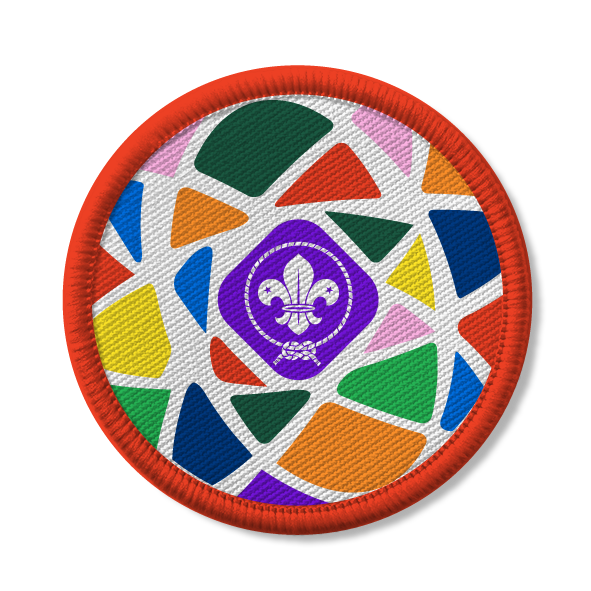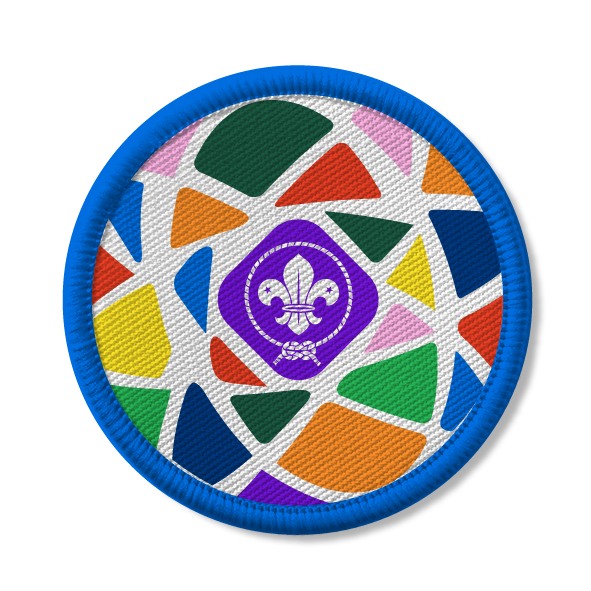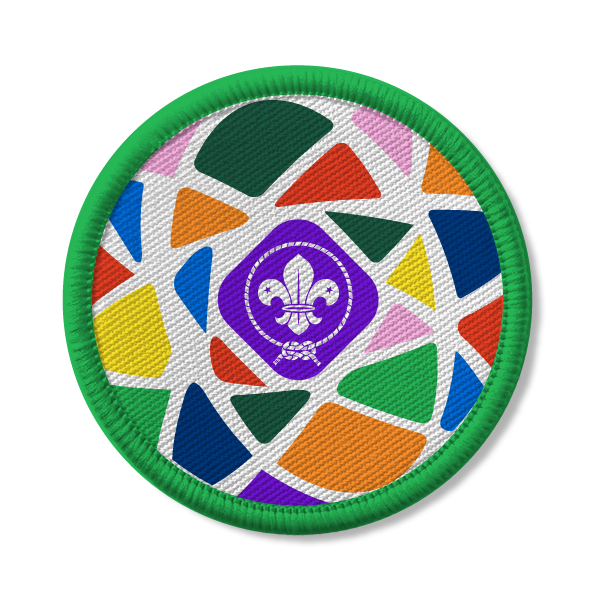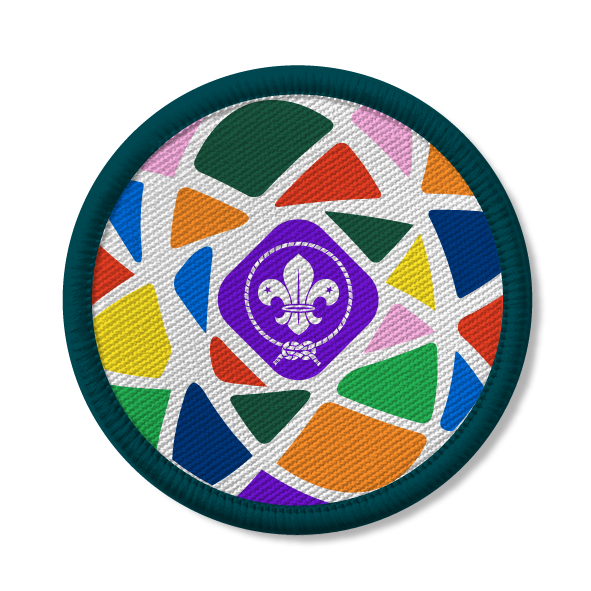
Bug-ingham palace
You’ll need
- String
- Pens or pencils
- Coloured pens or pencils
- A4 paper
- Natural materials (for example, leaves, twigs, feathers)
- Clean items of recycling
- Wooden pallets
- Bricks
- Old groundsheet or tiles
- Tools
Before you begin
- Use the safety checklist to help you plan and risk assess your activity. Additional help to carry out your risk assessment, including examples can be found here. Don’t forget to make sure all young people and adults involved in the activity know how to take part safely.
- Make sure you’ll have enough adult helpers. You may need some parents and carers to help out if you’re short on helpers.
What you'll need
- You'll want lots of different natural materials for your bug hotel. You could use old twigs, old logs and branches, dry leaves, straw or hay, bark, pine cones, bamboo canes, stones and hollow plant stems.
- For your items of recycling, great items to use are egg boxes, toilet rolls tubes, plant pots, tiles, straws and corrugated cardboard.
- You can build your bug hotel at any time of year, but you may find you have more natural materials such as straw, dry leaves, and hollow plant stems in autumn.
Plan your bug hotel
- If people are working towards their Community Impact Staged Activity Badge, everyone should talk about what they’ve learned about biodiversity. What creatures have they discovered? What have they already done to support the environment?
- Everyone should talk about why bug hotels are useful and the role bugs play in our environment. Can anyone think of another benefit of having a bug hotel in the local community? People might suggest that it’s a way to get others in the community more interested in nature. If they’re more interested in nature, they might think about how they can protect the environment.
- Everyone should think about outdoor areas in their local community. Where could a bug hotel go? They should try to think of somewhere nearby so it’ll be easy to check in on their guests. You could think about: land around your meeting place, a local park (there may be a community group you could contact), a local campsite, or a local NHS trust or housing association. You could even plan a walk around your local community to search for possible locations.
- Everyone should think about what sort of area they’ll need. You’ll want a firm and flat surface to build on. Some bugs like the sun, while others prefer to keep cool. If you want to attract a wide range of bugs, build your hotel so some of it’s in the sun and some is in the shade.
- Someone should get in touch with the landowner to get permission. It might help to share some information about how the bug hotel will help the environment and community.
- Everyone should get creative and draw their ideal bug hotel. What would it look like? What shape would it be? How many floors would it have?
- Everyone should share their design and work together to create a final design for the whole group to use. It’s up to you how you do this: people could vote for their favourite or pick the best bits from lots of people’s designs.
- Now it’s time to figure out how to bring the hotel to life. Everyone should think about what they’ll use to build a strong structure for the hotel. Where might they be able to get materials? There isn’t a right or wrong way to build a bug hotel! Pallets are a great way to quickly build a large structure with lots of gaps to fill, but you could also use bricks, wooden planks, and sheets. You could even make a completely natural bug hotel using logs or branches.
- Everyone should think about how they’ll fill their bug hotel. If they want to attract any particular bugs, they could think about the sorts of environments they like in the wild. They should think about what natural materials they’ll need to collect and how they’ll create smaller sections in their hotel.
- Everyone should plan how they’ll keep their bug hotel dry. They could make a roof using tiles, an old groundsheet, or wood.
- Everyone should make a list of tools they’ll need. You might want a drill to make holes in bricks or logs. Will you need a hammer and nails, or string, to attach anything together? You’ll need adult help if you’re using tools. Be particularly careful around power tools.
Build your bug hotel
This is just one example of how to build a bug hotel.
- Before you start building, you could record the bugs you can find in the area. This means that you’ll be able to track the difference your bug hotel makes. The Woodland Trust’s nature detectives spotter sheets may be helpful.
- Lay some bricks on some flat, even ground to create some sturdy foundations for your bug hotel. Leave spaces between the bricks to give minibeasts and small animals more spaces to enjoy. Make sure that each corner of your pallet is resting on a brick, and that the middle is supported too. Arranging the bricks in a H-shape should give you a sturdy base.
- Now, stack the wooden pallets one on top of the other to make the framework for your bug hotel. Don’t forget to put the biggest pallets at the bottom! If you want to make more space between each pallet, add a layer of bricks.
- As you build up the layers, carefully check that your hotel is sturdy and doesn’t wobble. Make some changes if you need to – you could use string or twine to give your structure some extra support.
- Fill in the gaps with different natural and recycled materials to give your visitors all sorts of different and interesting spaces to choose from.
- Start with the larger objects (for example, tiles, pots, and bricks with holes) and then fill the rest of the space with smaller objects (for example, pine cones, straw, sticks, and bark)
- Fill tubes or other containers with different materials to help keep things together. You could use plastic bottles with the ends cut off, kitchen roll or toilet roll tubes, pieces of pipe, old plant pots, or old mugs. You could also drill holes in logs to create extra spaces to hide – make them a variety of different sizes and depths, so bugs can find the comfiest spot.
- Once you’re happy that your structure is stable, add a roof to help keep your guests dry. You could create a flat roof with tiles or an old groundsheet. If you want a slanted roof, you could place some bricks in the centre, prop up two sheets of wood on either side, and attach them with a hammer and nails.
- Once you’re finished, choose a name for your hotel. You could use some spare wood to make a sign. You could use a hammer and nails to attach your sign, drill two holes to hang it with string, or create a free-standing sign to hammer into the ground.
Check in on your guests
Return at a later date to see how your hotel and your new guests are getting on. Without disturbing them, see what bugs you can spot and identify. Consider making a grid on a scrap piece of paper to count all the different types of bugs you're looking after.
You could explore biodiversity with Web of life and learning about potential guests with Snug as a bug.
The Woodland Trust’s nature detectives spotter sheets can help you identify bugs. You could use them to figure out what bugs are in your area or find out who’s checked in to your hotel.
The Seek app from iNaturalist can show you pictures of species local to you. You can use the camera on your device to get an identification – if your bug will stay still long enough that is!
People use all sorts of different words to talk about creepy crawlies.
In this activity, we’re using the word ‘bug’ to talk about all invertebrates or minibeasts.
These are animals that don’t have a backbone (a spine). Some are soft, such as worms or slugs, while others, such as spiders, have a hard outer layer called an exoskeleton.
Insects are a particular type of invertebrate. They've six legs and three parts to their body.
Some invertebrates, including bees and butterflies, help to pollinate plants.
Others, such as worms, eat dead plants and recycle nutrients back into the soil.
Some invertebrates do really important jobs, and we couldn’t grow our food without them.
However, some aren’t so helpful. Some invertebrates eat the crops that we plant for food, and we call these pests. Thankfully, some invertebrates eat pests and help us out.
Bigger animals, such as bats, birds, and badgers, eat bugs – they’re an important part of the food chain.
Even the most luxurious bug hotels can use recycled materials. You could ask:
- Local building suppliers. Can they donate any materials?
- Local shops or supermarkets. Do they have any old pallets to donate? Be careful and look out for nails sticking out.
- Anyone you know who’s been doing home renovations. They may have some spare bricks or tiles.
- Sticks and logs are great for woodlice, beetles, spiders, and centipedes.
- Holes and small tubes made out of bamboo, hollow stems, and drilled logs make the perfect home for solitary bees.
- Dry leaves, sticks, or straw will attract ladybirds.
- Corrugated cardboard is a favourite of lacewings. Roll it up inside a tube.
- Spiders like old terracotta plant pots.
- Pine cones bundled closely together, with some dried leaves in the gaps, will be a great place for ladybirds and lacewings to hide.
- Dry leaves will mimic a forest floor – home to lots of different invertebrates.
- Drilling holes in bricks or logs can provide extra hiding places for a range of bugs.
- Vertebrates can enjoy your bug hotel too! You could create larger holes with stones and tiles, to provide cool and damp conditions for frogs and toads.
- Think about how it’ll look too – do you want to make a sign for your hotel? You could hang it on your hotel or prop it up on the ground. What will you need to make a sign?
Reflection
This activity was about working as a team to create habitats for minibeasts. Think about what it was like spending time outdoors in nature.
How did it make you feel? Did you spot any creatures enjoying their new home?
Now that you’ve helped bugs in your local area, what other creations can you make to help wildlife? People might suggest making houses for bees or feeders for birds.
Safety
All activities must be safely managed. You must complete a thorough risk assessment and take appropriate steps to reduce risk. Use the safety checklist to help you plan and risk assess your activity. Always get approval for the activity, and have suitable supervision and an InTouch process.
- Rubbish and recycling
All items should be clean and suitable for this activity.
- Sharp objects
Teach young people how to use sharp objects safely. Supervise them appropriately throughout. Store all sharp objects securely, out of the reach of young people.
- Animals and insects
Be aware of the risks before interacting with animals. Be aware of anyone with allergies, and make alternative arrangements for them.
- Gardening and nature
Everyone must wash their hands after the activity has finished. Wear gloves if needed. Explain how to safely use equipment and set clear boundaries so everyone knows what’s allowed.
- Heavy and awkward objects
Never lift or move heavy or awkward items alone. Ask for help or, if possible, break them down into smaller parts.
- Outdoor activities
You must have permission to use the location. Always check the weather forecast, and inform parents and carers of any change in venue.
- Hand and electric tools
Inspect tools for any damage before each use. An adult should supervise people using tools, and people should follow instructions on how to use them correctly and safely. Tools should be properly maintained and kept sharp.
Use an appropriate surface and make sure materials are stable and supported when you’re working on them. You should cut and drill away from the body and in an area clear of other people. Be extra cautious of trailing cables and water when using electric tools. Always use a cordless tool if one’s available.
There’s no one way to make a bug hotel – it can be as simple or as complex as you like.
You could even start simple and then make an extension, or create a few smaller hotels.
Everyone should be able to play their part in building the bug hotel, whether it’s by moving big pallets, searching for natural materials, or creating smaller spaces for the bugs to hide.
Make sure the location you choose is accessible for everyone.
You could ask people to make smaller bug hotels in pairs or small groups, so that people can work with a buddy if needed to support them.
All Scout activities should be inclusive and accessible.
Plant British wildflowers around your hotel for insects, such as bees and butterflies. You could even see if you could grow them on the roof of your bug hotel.
You could make a home for hedgehogs at the bottom of your bug hotel, too.
Think about how you can use your bug hotel to help others learn about nature. Can you make any waterproof signs next to it with insect facts? Or paint insects on rocks with fun facts to leave for people to take home if they find them?
The group should have the chance to get stuck in with both planning and building the bug hotel. Encourage them to make it their own and create something they’re really proud of.






